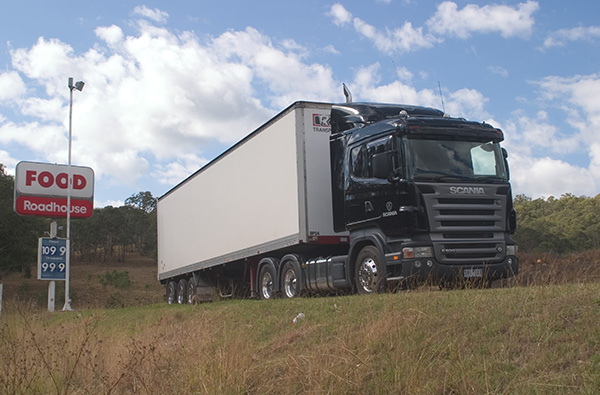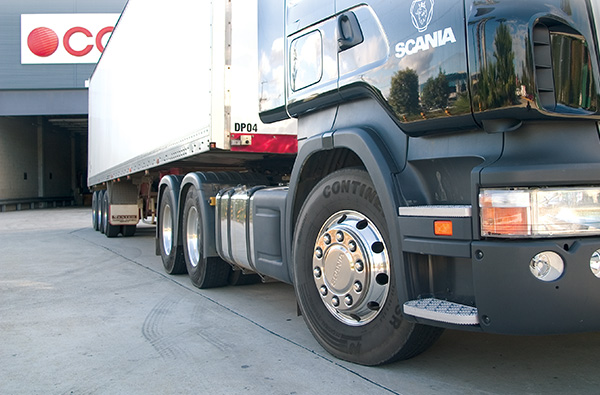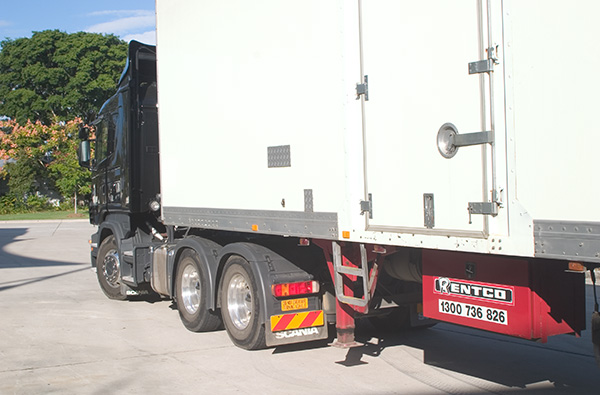Conventional wisdom tells us we always need a bogey drive prime mover. Scania aren’t so sure, writes Tim Giles
Scania is a company that doesn’t mind being different and they have been spruiking the value of a 6×2 prime mover for some time.
ATN took the opportunity to get a single drive prime mover out on the road and see how it performed. This particular R500 prime mover has a single drive axle and behind that an air-suspended lazy axle.
This one is pulling a single trailer and the truck would probably not be able to handle anything more than that.
The 6×2 format using lifting tag axles like this or fitted with a pusher axle is standard fare in the European market.
This is especially the case in the United Kingdom where a third axle on the prime mover gains a considerable GCM concession.
Australian operators have shied away from these types of axle set-ups in the past looking for the improved traction and better reliability of a tandem drive on our rougher roads and loose surfaces.
The question has to be, how often does a truck travel on the worst of our country roads? Many trucks only operate on major highways and big city streets.
Scania is introducing these prime movers to fleets who they reckon could gain the benefits of lower tare and improved fuel economy that the 6×2 claims to offer.
Engine
The 500 horsepower V8 engine will probably be the highest power anyone could ever need on a 6×2 prime mover.
Transmission
Spending a lot of time in traffic going from traffic light to traffic light points out the deficiencies of Scania’s manual 14-speed gearbox option.
It’s big and quite heavy and serves to illustrate that the Opticruise is a much better choice if there’s going to be a lot of around-the-town driving.
If you are driving with this box all of the time you probably learn to live with it but the box will feel awkward to someone used to something like a Roadranger.
Cab and Controls
In the quiet of the cab the driver can set all of the automatic systems from the steering wheel controls. Cruise control is set, as is the station on the radio and it is possible to lean back into the seat and enjoy the view.
The three buttons along the bottom of the steering wheel work really well and are in just the right place for controlling the retarder and cruise control.
The buttons on the top left and right on the steering wheel work well as radio controls.
As a living space in the cab it is quiet and smooth and the climate control in the Scania is very good.
The way the buttons and controls are laid out is well done and they are easy to the touch. It’s a pity that the information screen is not very easy to look at a lot of the time in bright daylight.
The solution that Scania has come up with is to give the cab a full size bed with inserts that have to be put in with the seats pushed forward.
It’s not ideal — the two pillow sized inserts are likely to disappear in a truck that has several drivers using it regularly.
This particular model seems to have a softer cab suspension than some other R Series trucks driven in the past.
The explanation is either that there is a different setting for the cab suspension or that the 6×2 rocks more than the 6×4. It is hard to tell.
Performance
The short nature of the ATN road test is hardly going to prove any really conclusive fuel savings but can give an indication of what can be expected.
Pulling a tri-axle pan and loaded to just over 36 tonnes the 500hp engine hardly broke into a sweat on our road test.
There is an indication early on in the trip that there is something different going on at the drives. A particularly rough and overused motorway bridge in Rocklea is uncomfortable and the driver got a rougher ride than normal.
The undulations in the road cause a momentary loss of traction as the drive dropped into a dip while the lazy is still at the top of a bump.
The extra back and forwards rocking of the prime mover on that section of road was the only point in the day’s drive that the 6×2 truck’s configuration became obvious.
Leaving Brisbane on the Cunningham Highway, the smooth power from the V8 made for easy acceleration and only a little slowing of the truck on the climbs.
The first hard work of the day for the truck was the climb up the Cunningham Gap. The truck handled the climb well and ended up climbing Cunningham Gap doing 47 or 48 kph.
The engine is sitting at 1400 rpm in fifth low gear on the manual 14-speed gearbox.
At that speed the truck is not struggling at all and it’s sitting very easily at that rpm. Later on in the climb it starts to struggle on the steeper sections and it’s necessary to drop a gear.
The downchange may not have been necessary but most drivers like to climb with a bit in reserve on a grade like the Gap. If the truck was more familiar it may have been possible to feel secure in a higher gear and make the climb a little faster.
The rest of the climb saw the truck in fourth high gear running at about 1600 rpm at a speed of just over 42 kilometres per hour.
The Scania is doing it easy at this speed but this driver was not convinced it would be a good idea to change up. In the end, the Scania climbed the Gap in a creditable 10 minutes 15.01 seconds.
Driving along at 10:30am, it is very difficult to read the LCD display. This is a problem with a few European-style trucks — they are fitting the latest computerised system and the screen is the driver interface.
All of this fantastic information available to the driver is not very useful if they have to put their hand over the dash to read it.
In order to comply with our complicated regulations about axle loads there are a set of controls for the lifting axle.
The axles must employ a weight monitoring system and, as a result, there is a section in the scroll down menu where the prime mover’s axle weights are shown.
The system is necessary because if the sensor on the drive axle shows more than six tonnes then the second axle has to be lowered.
In the event of a problem with traction it is possible to dump the air in the second rear axle and throw weight onto the drives for 20 or so seconds.
As it happens it was impossible to test that function as the need never looked like arising. Climbing a steep hill on a wet undulating road surface might do it but in normal conditions it is very unlikely to be needed.
The worst problem likely to happen is when entering or leaving premises where there may be a deep gutter over which the drive axles could become suspended.
ATN’s test route includes open highway driving and visiting urban delivery sites, which failed to come up with anything that could cause any problem.
There seems to be no real difference in feel from the driver’s seat between a 6×2 and 6×4. The Scania R series is a good truck to drive and the feel is always good and the vision all around is excellent for a high cab
It is no problem in the thick traffic travelling up the Gympie Road to Chermside in Brisbane. The lanes here are particularly tight but it’s easy to keep out of trouble.
Verdict
From a power point of view the 500hp rating of the V8 engine is running well within its capacity and it shows. It’s not working hard and the combination of this and the 6×2 set up should keep fuel use down.
There is a green band that moves about on the tachometer to indicate where the rpms should be. It is useful and reminds the driver to change up or down a lot more precisely than they would normally do in a real world situation.
All of these factors seem to be aimed at fuel economy and the name of the game is lower fuel use for operators. This 6×2 does seem to show some real savings.
Running at just over 36 tonnes and not being driven in a way that is trying to save fuel, the Scania managed 2.16 km/litre.
This figure is the best that our testing has found on our difficult test route on a single trailer prime mover. The result is not scientifically proven but this does indicate that there are some real savings to be made by opting for a single drive.
It would be a matter of judgement for the operator as to whether they would choose such an option. There is a risk involved with the possibility that traction issues may occur down the track.
Residual values are also likely to be considerably lower in view of the industry’s suspicion of 6×2 trucks.
The important thing is there is a choice available that can offer fuel savings and still perform quite well.





